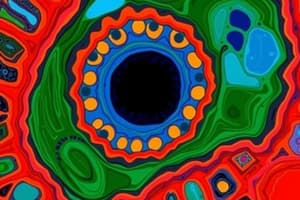Podcast
Questions and Answers
Which organelles are membrane bound?
Which organelles are membrane bound?
- Nucleus, Endoplasmic reticulum, Golgi apparatus (correct)
- Plastids, Vacuoles
- Lysosomes, Peroxisomes, Mitochondria
- Ribosomes, Cytoskeleton
What is the main function of the nucleus?
What is the main function of the nucleus?
- Produce energy for the cell
- Store genetic information and act as a control center (correct)
- Break down waste materials
- Synthesize proteins
What is the composition of the nuclear envelope?
What is the composition of the nuclear envelope?
- Double membrane with inner and outer nuclear membrane (correct)
- No specific membrane structure
- Triple membrane with two outer and one inner nuclear membrane
- Single membrane with only outer nuclear membrane
What is found in the nuclear interior?
What is found in the nuclear interior?
Which organelle disassembles during cell division?
Which organelle disassembles during cell division?
Which organelle is involved in the exchange of molecules between the perinuclear space and the nuclear interior?
Which organelle is involved in the exchange of molecules between the perinuclear space and the nuclear interior?
Which proteins enable the fusion of vesicles with correct target membranes?
Which proteins enable the fusion of vesicles with correct target membranes?
What is the function of COPI vesicles in vesicle transport?
What is the function of COPI vesicles in vesicle transport?
What is the primary role of Clathrin-coated vesicles?
What is the primary role of Clathrin-coated vesicles?
What are v-SNAREs and t-SNAREs involved in?
What are v-SNAREs and t-SNAREs involved in?
What is the function of COPII proteins in vesicle transport?
What is the function of COPII proteins in vesicle transport?
What is the main function of lysosomes?
What is the main function of lysosomes?
What is the function of the nuclear lamina?
What is the function of the nuclear lamina?
What is the role of the nuclear pore complex?
What is the role of the nuclear pore complex?
What is the function of the nucleolus?
What is the function of the nucleolus?
Where are genes for 5.8S, 18S, and 28S rRNAs located?
Where are genes for 5.8S, 18S, and 28S rRNAs located?
What happens to nucleoli at the beginning of mitosis?
What happens to nucleoli at the beginning of mitosis?
What is the role of the perinuclear space?
What is the role of the perinuclear space?
What is the main function of rough endoplasmic reticulum (ER)?
What is the main function of rough endoplasmic reticulum (ER)?
Where are most cell lipids, including phospholipids and cholesterol, synthesized?
Where are most cell lipids, including phospholipids and cholesterol, synthesized?
What is the function of the sarcoplasmic reticulum?
What is the function of the sarcoplasmic reticulum?
Where does mRNA relocate to after leaving the nucleus?
Where does mRNA relocate to after leaving the nucleus?
What is the main function of smooth endoplasmic reticulum (ER)?
What is the main function of smooth endoplasmic reticulum (ER)?
Which organelle is the largest in most cells, representing about 10% of the total cell volume?
Which organelle is the largest in most cells, representing about 10% of the total cell volume?
What is the main function of Smooth Endoplasmic Reticulum (SER)?
What is the main function of Smooth Endoplasmic Reticulum (SER)?
What is the role of Sarcoplasmic Reticulum (SR) in muscle cells?
What is the role of Sarcoplasmic Reticulum (SR) in muscle cells?
What triggers Ca2+ release from Sarcoplasmic Reticulum (SR) during muscle contraction?
What triggers Ca2+ release from Sarcoplasmic Reticulum (SR) during muscle contraction?
What is the main function of Golgi Apparatus (GA) in the cellular secretory pathway?
What is the main function of Golgi Apparatus (GA) in the cellular secretory pathway?
How are the Golgi stacks linked together within the Golgi Apparatus (GA)?
How are the Golgi stacks linked together within the Golgi Apparatus (GA)?
What occurs at the cis-face of Golgi Apparatus (GA) in the processing pathway?
What occurs at the cis-face of Golgi Apparatus (GA) in the processing pathway?
Study Notes
Cellular Organelles and Their Functions
- Lipid flippases and floppases are ATP-dependent membrane proteins that maintain phospholipid distribution in the bilayer.
- Smooth Endoplasmic Reticulum (SER) detoxifies compounds in specialized cells like liver cells and increases detoxification enzymes in response to drugs or alcohol.
- Sarcoplasmic Reticulum (SR) is specialized endoplasmic reticulum in muscle cells, storing Ca2+ ions for muscle contraction.
- SR consists of terminal cisternae communicating with T-tubules and plays a crucial role in muscle contraction and relaxation.
- Muscle contraction is mediated by acetylcholine binding to receptors in the sarcolemma and triggering Ca2+ release from SR.
- Muscle relaxation occurs when Ca2+ is pumped back to the SR by Ca2+-ATPase pumps, allowing the muscle fiber to relax.
- Golgi Apparatus (GA) serves as a sorting station in the cellular secretory pathway and is involved in processing and delivering cellular components.
- GA is composed of flat sacs (cisternae) forming the Golgi stack, linked together by tubular connections.
- The Golgi stacks are linked by microtubules, stabilizing the position of GA within the cell and enabling transport of vesicles among cisternae.
- The Golgi apparatus has a horseshoe shape with distinct cis and trans faces, playing different roles in the processing pathway.
- The cisternae of the Golgi serve as chambers for different chemical reactions, including glycosylation and assembly of molecules.
- Vesicles containing proteins and lipids enter the cis-face of GA, undergo modification, and are delivered to specific intracellular or extracellular locations.
Studying That Suits You
Use AI to generate personalized quizzes and flashcards to suit your learning preferences.
Description
Medium




